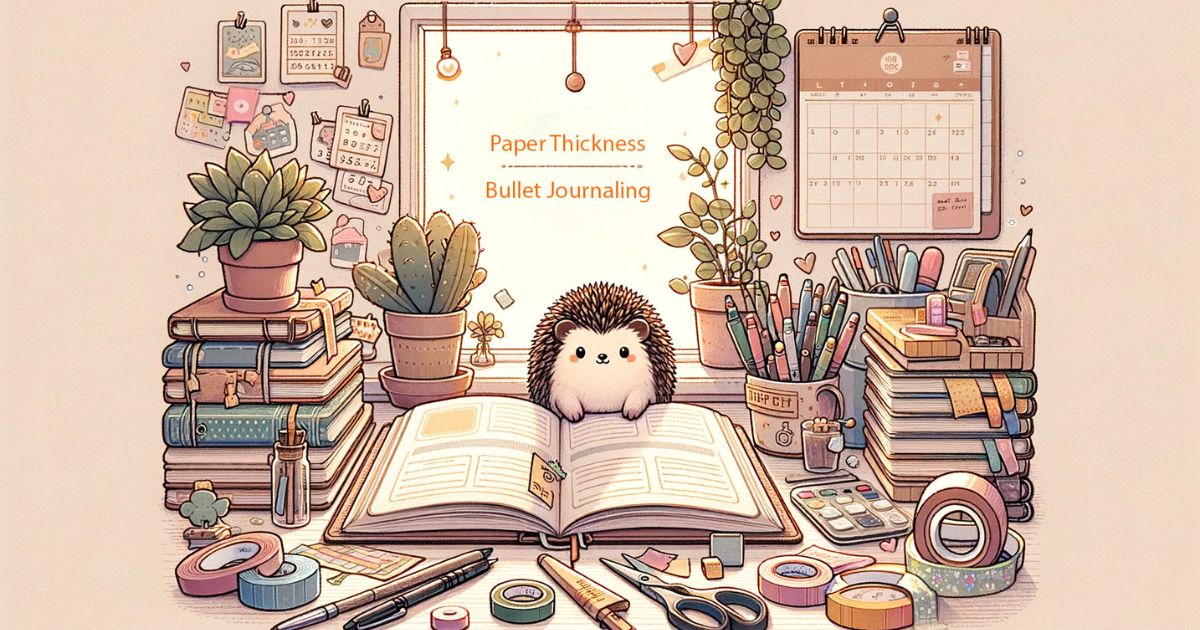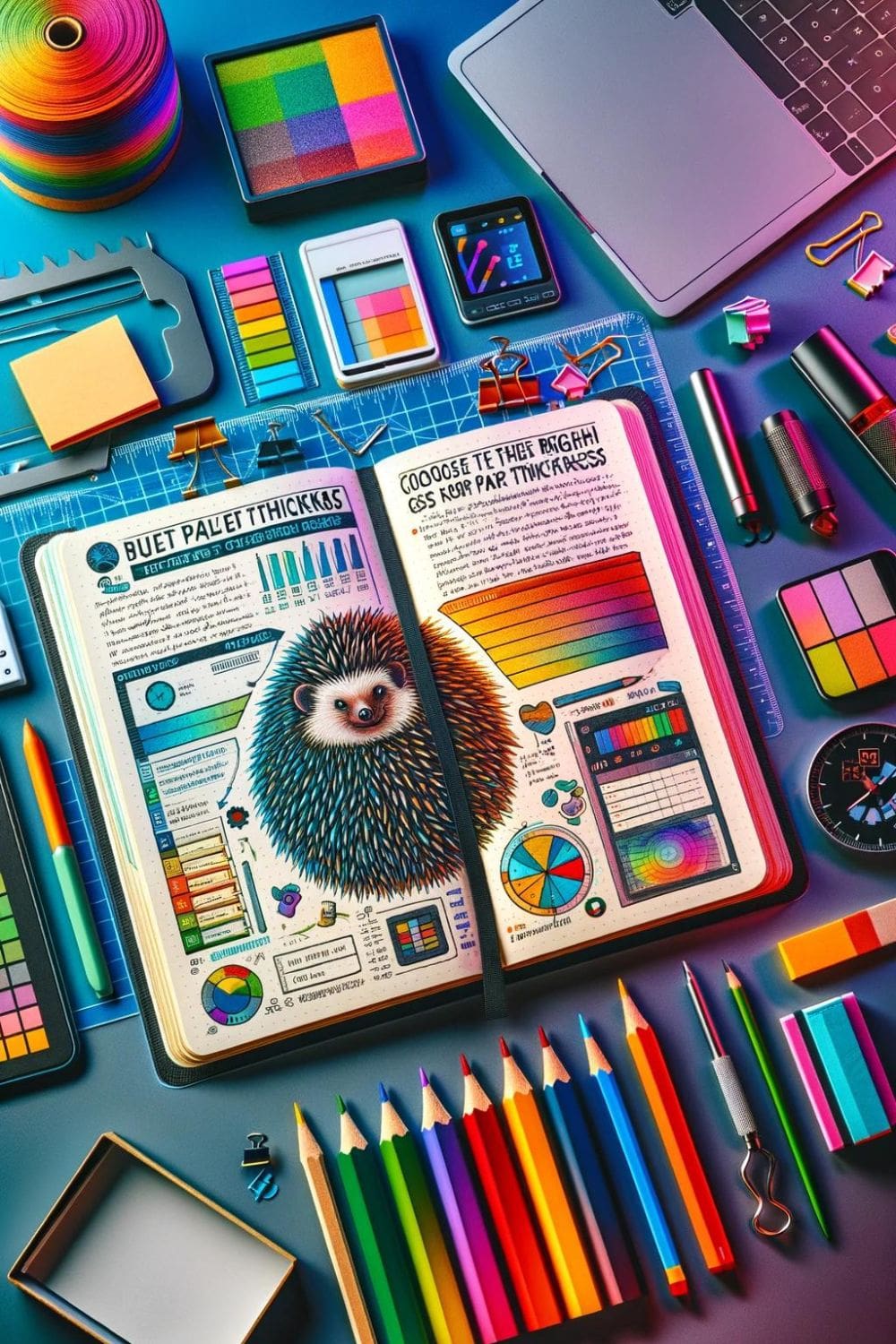I learned the hard way how vital paper thickness is in Bullet Journaling.
The paper you choose is much more than a backdrop for your to-do lists and creativity.
Paper thickness matters because it determines how well the paper can handle different media without bleeding, ghosting, or tearing. Often measured in GSM (grams per square meter), heavier pieces provide a sturdier canvas for those who favor markers or watercolors in their journals.
When I started this journey, I didn’t know what any of this meant; honestly, GSM is still confusing. However, canvas is an excellent way of thinking about it. Consider how a canvas has to be thick enough to handle paint.
When I first attempted to Bullet Journal, I found it annoying because I would pick beautiful journals, but the ink would bleed through the pages. Another thing that would happen is that the paper would become textured from the writing. So when I turned the page, not only would ink bleed through, but the page would be bumpy. It was just such an annoying experience.
Well, paper thickness matters a lot. When I first realized how crucial this was, I got in the car and drove up to Walmart. None of the journals in stock had a high GSM. So I left and came home. The next thing that I did was jump on Amazon and start shopping.
Choosing the right paper thickness for your bullet journal can dramatically improve your journaling experience.
If you simply wish to write with a pen, a lighter-weight paper might suit your needs perfectly, providing a smooth writing experience with minimal bleed-through. This may be fine for you if you have a light touch when writing. However, I have a very heavy hand when writing.
Conversely, a thicker paper could be your best friend for those looking to express their artistic side through vibrant doodles or heavy inking. The decision is deeply personal and depends on your journaling style and how you intend to use your bullet journal.

Key Takeaways
- Paper thickness in bullet journaling is crucial for pen performance and color vibrancy.
- Heavier GSM paper resists bleeding and ghosting better for journaling.
- Personal journaling style dictates the best paper weight for your needs.
The Importance of Paper Thickness in Bullet Journaling
When choosing your bullet journal, paper thickness can make a real difference in how your journal holds up to different pens and usage.
Durability
Thicker paper in your bullet journal means more resilience against wear and tear. As you carry your journal around, pages with heavier weight withstand folding, erasing, and repeated handling better than their thinner counterparts.
Ink Bleed-Through
Do you hate seeing your writing or art on the other side of the page? Thicker paper minimizes the chance of ink bleed-through. Journals with substantial paper give you the freedom to use a variety of pens and markers without worrying about the ink seeping through to the other side.
Ghosting
Even if the ink doesn’t fully bleed through, thinner paper often shows ghosting — faint impressions of your work visible on the other side. By opting for a journal with thicker paper, you significantly reduce ghosting, keeping each page clean and readable.
Writing Experience
Your writing experience is directly influenced by paper thickness. The thicker paper provides a smoother, more controlled surface, allowing for a consistent ink flow and cleaner lines. It also reduces the likelihood of indentations when you press down with a pen.

Choosing the Right Paper Thickness for Your Bullet Journal
When setting up your bullet journal, paper thickness is a crucial element that influences both your writing experience and the longevity of your journal.
Tips for Selecting the Ideal Paper Thickness
- GSM Guide: Paper thickness in bullet journals is typically measured in GSM (grams per square meter). A higher GSM means a thicker paper.
Standard writing paper usually ranges from 60 to 90 GSM, while 100 to 120 GSM offers a more durable feel with less show-through.
For those who don’t want any ink bleeding or ghosting, paper above 160 GSM provides a more substantial writing surface, but remember, it will also make your journal bulkier.
Considerations for Art and Decoration
- Creative Mediums: If you’re into decorating your bullet journal with markers, brush pens, or watercolors, opt for a higher GSM paper. This ensures excellent resistance to bleeding and show-through. Higher GSM paper is ideal for heavier or wetter mediums.
- Binding and Page Count: Consider that the thicker the paper, the fewer pages your journal will have if it’s meant to stay at a reasonable size. This trade-off can affect your journal’s length before you need a new one. A thicker paper is suitable for most needs, but if longevity in page numbers is your goal, finding a happy medium may be your best bet.
The bottom line
My home office is a bit of a mess because journals are everywhere right now.
This experience of finding the best GSM paper thickness for me took me by surprise. It is frustrating because I will have to buy journals more often. The higher GSM journals have fewer pages, but I believe it is worth it.
I now realize that part of the reason that I have abandoned journals is because the bleed and pen texture issue was just so annoying. So now, I am also excited because now I have a journal that I actually want to use.

